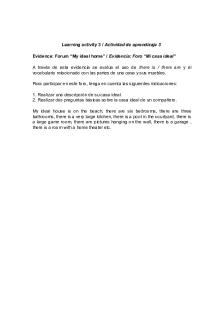Day 9 My Home Away from Home Medical Tourism in Los Algodones PDF

| Title | Day 9 My Home Away from Home Medical Tourism in Los Algodones |
|---|---|
| Course | The Border/ La Frontera |
| Institution | Brown University |
| Pages | 3 |
| File Size | 68.5 KB |
| File Type | |
| Total Downloads | 78 |
| Total Views | 123 |
Summary
Taught by Professor Hu-DeHart...
Description
Day 9: My Home Away from Home? Medical Tourism in Los Algodones Los Algodones, Baja California, is a small Mexican town located on the most northeastern tip of Mexicali, approximately 10 miles west of Yuma, Arizona. Los Algodones translates in English as “the cottons”, a fitting name due to the acres of cotton fields we drove past during the hour-long drive from downtown Mexicali. However, the cotton fields weren’t the only sea of white in Los Algodones… When I stepped off the bus in Los Algodones, I immediately felt like I was back home in Palm Beach County, Florida. No, not because of the warm weather, expansive blue sky, and wealth of green space. It was actually the people! In Los Algodones, there were more Americans than Mexicans. But not just any Americans, specifically older, white Americans, or who the locals call “snowbirds”. As the rest of our group marveled at the number of old white people who packed the Los Algodones streets, I couldn’t help but laugh to myself because the demographic resemblance to my hometown was impeccable. Founded on July 27, 1894, Los Algodones is a hub for medical tourism, or when people travel abroad to obtain medical treatment. In the past, medical tourism has referred to those who travel from less-developed countries to receive treatment that is unavailable to them at home in highly developed countries. In recent years however, medical tourism has also come to include those from developed countries who travel to less-developed countries for lower-priced medical treatments. In Los Algodones, the prevalence of inexpensive prescriptions and medical care catering to Canadian and U.S. American senior citizens has prompted an explosion of pharmacies, opticians, and dental offices dating back to the 1980s. With over 300 dental offices within a five block radius, Los Algodones has approximately 600 dentists who service mostly uninsured Canadian and American health tourists who save anywhere from 40 to 60 percent on dental services. As I walked through the streets of Los Algodones, pharmacy and dental promoters shoved promotional flyers and business cards in my hands as they pointed me in the direction of their preferred office. Once I realized the breadth and depth of the Los Algodones medical industry, I kept a tally of the number of times someone asked “You looking for dentist/pharmacy today, lady?” The final count was 34! It turns out that Hector’s aunt had an aunt (or family friend?) that owned a dental practice in Los Algodones. She was inviting enough to close down the office to allow us a brief tour of the practice. The office looked just like my dentist in Florida, complete with several examination rooms, X-ray machines, and a range of services from routine cleanings to root canals and crowns. Lupita, the office receptionist and dentist assistant told us that at the height of the season (the winter), the office receives about 10 clients a day, and about 12 per week in the slow season. When I asked how so many medical offices are able to stay in business with such intense competition, Lupita replied that because Los Algodones is the world capital of dentistry, there are enough customers to go around. Aside from that, offices retain clients by advertisement and
positive customer reviews. Enticed by the low-prices, Hector and Rene got their teeth cleaned during our free time! After a lunch of delicious street tacos, we had some free time to explore Los Algodones on our own and do some shopping. Because Los Algodones is mostly a tourist town, the prices were much higher than they were in Tijuana. Per Professor Hu-DeHart’s advice, I broke in my bartering skills to buy a beautiful handmade blanket for $12 USD (originally $25) and a handmade figurine for 90 pesos (approximately $4.86 USD, original price $8 USD). Although I didn’t really like bartering, it was the norm in all of the shops I went to because the vendors were quick to mark items down as soon as I showed disinterest. While bartering, I was careful not to behave like some of the Canadian and U.S. American tourists I saw who were really nasty to the Mexican vendors about marking prices down. Our last activity in Los Algodones was a lecture and discussion with Professor Carlos Romero, Professor Kenia Ramirez, and Jean Bernaud Gelin, or “Mike”, a Haitian immigrant living in Mexicali. What resonated with me most from this discussion is Mike’s story as a Haitian migrant attempting to move to the United States but instead settling in Mexico. After the 2010 earthquake in Haiti and the hurricane shortly after, a few South American countries like Brazil and Chile welcomed Haitians to work in their country. In light of the World Cup in Brazil, thousands of Haitians migrated to Brazil for employment, but were forced to leave the country when Brazil fell into economic and political problems. These migrants then set their sights on the United States, where President Obama offered temporary protected status (TPS) to African migrants (Mike and other Haitians pretended to be from Africa along their journey). Unfortunately, right when Mike arrived in Baja California, Mexico, President Obama closed the border and did not allow any more Africans to gain political asylum. With no Plan B in mind, Mike and hundreds of other Haitian migrants decided to settle in Mexico, and with the help of people like Professor Ramirez and organizations like Casa del Migrante (along with other migrant shelters across the Mexican borderlands), Mike and other Haitian migrants learned Spanish and became integrated into Mexican society and culture. Now, Mike is an engineering student at UABC (Autonomous University of Baja California), speaks fluent Spanish, and has lived in Mexico for almost four years. Despite a difficult journey (it was too painful for Mike to share too many details of his journey), Mike’s story is filled with resilience, determination, drive, and motivation. He reminded us all what it means to be a migrant and a child of immigrants, and how we must not take any opportunity for granted. ● Engineering student at UABC ● Has lived in Mexico for almost 4 years ● Haitian earthquake in 2010, more than 300,000 people died
○ Some South American countries welcomed Haitians to migrate to work ○ Soccer World Cup in Brazil. Haitian migrants had the opportunity to work in Brazil and Chile. ○ In the last 4 years, Brazil fell into economic and political problems ○ So, Haitians left Brazil in search of better work so that they could support themselves and their families ● President Obama offered TPS (Temporary Protection Status) ○ Most of the Haitians crossed 10 countries to get to Mexico. They said they were Africans and when they arrived in Mexico, people thought they were from Africa. ○ When Mike arrived in Mexico (Baja California), Obama closed the border and did not allow any more Africans to gain political asylum ■ The Haitians' Plan A failed, so their Plan B was to stay in Mexico ■ Haitians arrived in Tijuana without clothes, shoes, food, etc. Went to migrant shelters where they received help. ■ Mike got a job in a candy store to earn money to take entrance exam to enroll in University ■ He didn't pass the exam at first because he couldn't speak Spanish and it was difficult to read the test ■ He was sad, but then he motivated himself and started to study a lot. He was invited by schools, television stations, and a lot of other places to speak about his experience migrating from Haiti ■ Then, he passed! He had help from teachers, but did a lot of the work himself '...
Similar Free PDFs

Forum My ideal home paula
- 2 Pages

Effectiveness of Work from Home
- 5 Pages

Los mares de honduras - home
- 2 Pages

Train Like Me 21 Day Home Challenge
- 38 Pages

MY Ideal HOME- MI CASA Ideal
- 1 Pages

Take home exam - Take Home exam
- 10 Pages

Take home exam - take-home test
- 1 Pages

Home-care
- 22 Pages

Home - pastillas
- 1 Pages

A DAY IN MY LIFE
- 1 Pages
Popular Institutions
- Tinajero National High School - Annex
- Politeknik Caltex Riau
- Yokohama City University
- SGT University
- University of Al-Qadisiyah
- Divine Word College of Vigan
- Techniek College Rotterdam
- Universidade de Santiago
- Universiti Teknologi MARA Cawangan Johor Kampus Pasir Gudang
- Poltekkes Kemenkes Yogyakarta
- Baguio City National High School
- Colegio san marcos
- preparatoria uno
- Centro de Bachillerato Tecnológico Industrial y de Servicios No. 107
- Dalian Maritime University
- Quang Trung Secondary School
- Colegio Tecnológico en Informática
- Corporación Regional de Educación Superior
- Grupo CEDVA
- Dar Al Uloom University
- Centro de Estudios Preuniversitarios de la Universidad Nacional de Ingeniería
- 上智大学
- Aakash International School, Nuna Majara
- San Felipe Neri Catholic School
- Kang Chiao International School - New Taipei City
- Misamis Occidental National High School
- Institución Educativa Escuela Normal Juan Ladrilleros
- Kolehiyo ng Pantukan
- Batanes State College
- Instituto Continental
- Sekolah Menengah Kejuruan Kesehatan Kaltara (Tarakan)
- Colegio de La Inmaculada Concepcion - Cebu





